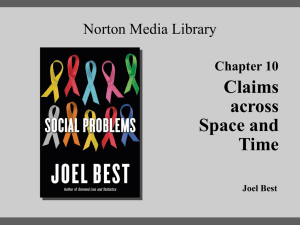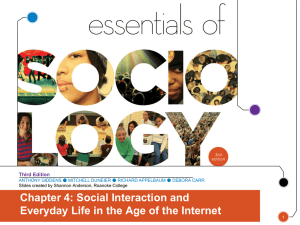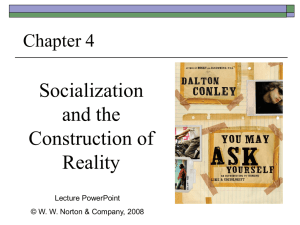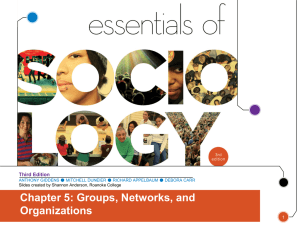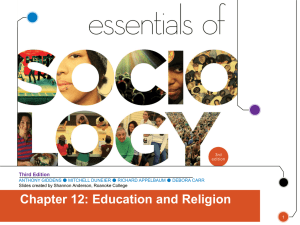Chapter 15
advertisement
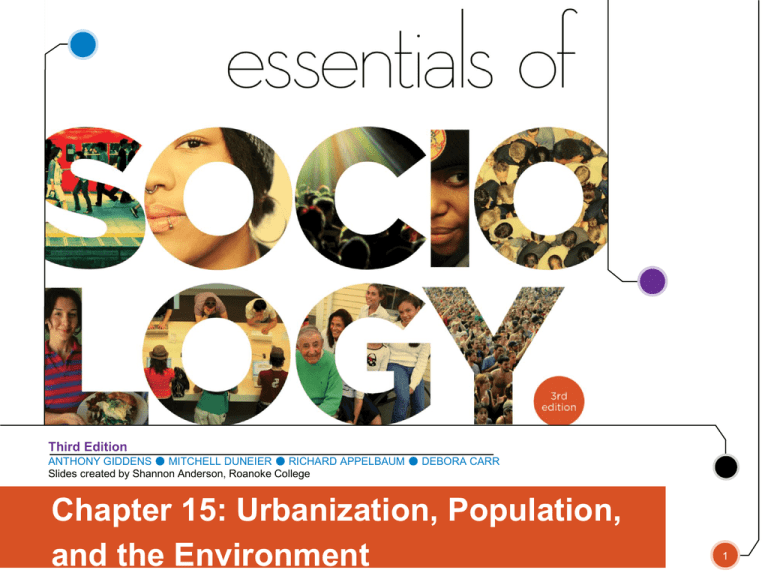
Third Edition ANTHONY GIDDENS ● MITCHELL DUNEIER ● RICHARD APPELBAUM ● DEBORA CARR Slides created by Shannon Anderson, Roanoke College Chapter 15: Urbanization, Population, and the Environment 1 Important issues • • • • • How cities have changed and why Rural, urban, and suburban living Globalization and urbanization Population growth and its consequences Globalization, urbanization, growth, and the environment © 2011 W. W. Norton Co., Inc. 2 Ancient cities • Organized very differently than today’s cities, both spatially and socially • Centers for culture, science, commerce, and so on • The vast majority of the population lived in rural towns and communities, with little or no connection to cities. © 2011 W. W. Norton Co., Inc. 3 What is urbanization? • Urbanization is a shift in population from rural living to living in cities and towns. • Occurred alongside industrialization. • London as a prime example: – 1800: 1.1 million people – 1900: > 7 million people • The United States: 1800: <10% urban 2010: approximately 80% urban © 2011 W. W. Norton Co., Inc. 4 Global urbanization • 1900 onward: urbanization became a global, not just national, process. • That trend intensified from 1950 forward. • Global, urban population statistics: – 1975: 39% – 2000: approximately 50% – 2050: estimated 70% © 2011 W. W. Norton Co., Inc. 5 Theories of urbanism • The Chicago School – Urban ecology • Cities organized naturally so as to generate equilibrium • Robert Park – Urbanism as way of life • Urban interaction problem • Louis Wirth © 2011 W. W. Norton Co., Inc. 6 The “urban interaction problem” is a necessity for city dwellers— respecting social boundaries when so many people are in close physical proximity all the time. Essentials Of Sociology, 3rd Edition Copyright © 2011 W.W. Norton & Company Theories of urbanism • Jane Jacobs, “Eyes and ears” – Multiplicity of people on the streets increases security through watchfulness • Urbanism as a created environment – David Harvey – Manuel Castells © 2011 W. W. Norton Co., Inc. 8 Rural life • Stereotypes of idyllic rural America often misrepresent rural realities • Rural areas = 75% of land, but hold only 17% of the population. • The rural population has been in decline for most of the twentieth century. © 2011 W. W. Norton Co., Inc. 9 Declining rural population • • • • • Declines in farming and other rural industries High poverty rates Few opportunities or amenities Few government services Hard to attract new residents • New technologies and social programs work to reverse these trends © 2011 W. W. Norton Co., Inc. 10 Suburban development • Suburbs are towns that develop as residential hubs around industrial cities. • Suburbs developed during the economic boom that followed World War II. • This happened with significant government assistance. • Suburban populations have been largely white. © 2011 W. W. Norton Co., Inc. 11 Suburban Levittown, New York, in the 1950s. Essentials Of Sociology, 3rd Edition Copyright © 2011 W.W. Norton & Company Problems with urban life • • • • Suburbanization led to changes in cities. Industries left cities, taking mostly bluecollar jobs with them. This led to increased residential segregation as poorer, non-whites remained in cities. This left cities with lower tax revenues, leading to perpetual financial problems. © 2011 W. W. Norton Co., Inc. 13 Urban renewal • • Gentrification is a process whereby wealthy people buy and renew deteriorating properties in cities. Tends to be good for property values but bad for the previous, low-income residents. © 2011 W. W. Norton Co., Inc. 14 Clinton Street was a grim, graffi ti- ridden streetscape Essentials Of Sociology, 3rd Edition Copyright © 2011 W.W. Norton & Company It has evolved into a lively restaurant row on New York’s Lower East Side Essentials Of Sociology, 3rd Edition Copyright © 2011 W.W. Norton & Company Global cities • Saskia Sassen’s global cities are those that house major transnational corporations and other global firms. • These are the seats of global power and control. • Global cities are sites of extreme wealth and poverty. © 2011 W. W. Norton Co., Inc. 17 Urbanization in the developing world • Africa and Asia are still predominantly rural— only around 40% urban. • The urban population is growing more rapidly in these regions of the world. © 2011 W. W. Norton Co., Inc. 18 Urbanization in the developing world • Major environmental risks are posed by such rapid growth, overcrowding, and poverty: – Housing – Pollution – Sanitation – Water supply © 2011 W. W. Norton Co., Inc. 19 Studying global populations • • The study of population is called demography. Important terminology: – – – – Crude birthrate Fertility and fecundity Crude death rate (mortality) Life expectancy and life span © 2011 W. W. Norton Co., Inc. 20 Map 15.1 Population Growth Rate, 1980–2002 Essentials Of Sociology, 3rd Edition Copyright © 2011 W.W. Norton & Company Consequences of population change • Rapid population growth and urbanization may lead to: – – – – – – Increased internal migration Significant environmental challenges Health concerns Increased crime More and larger squatter settlements Famine and food shortages © 2011 W. W. Norton Co., Inc. 22 The environment and society • The way of life in Western societies creates major environmental challenges. – Massive amounts of non-recyclable waste – Pollution – Depletion of resources and biodiversity © 2011 W. W. Norton Co., Inc. 23 The environment and society • Global warming—also a human product— affects us all. • Energy consumption may outstrip certain resources. © 2011 W. W. Norton Co., Inc. 24 Figure 15.2 Shares of Total World Consumption of the Richest 20 Percent and the Poorest 20 Percent, 1995 Essentials Of Sociology, 3rd Edition Copyright © 2011 W.W. Norton & Company Sustainable development and change • New sustainable development policies seek equilibrium between environmental concerns and the economy. • Such policies tend to work well for wealthy countries at the expense of poorer countries. © 2011 W. W. Norton Co., Inc. 26 This concludes the Lecture PowerPoint Presentation for Chapter 15: Urbanization, Population, and the Environment For more learning resources, please visit our online StudySpace at: http://www.wwnorton.com/college/soc/essentials-of-sociology15/ W. W. Norton & Company Independent and Employee-Owned © 2011 W. W. Norton Co., Inc. 27 Clicker Questions 1. The statement that “cities do not grow up at random but grow in response to advantageous features of the environment” reflects which view of urbanism? a. Wirth’s urbanism as a way of life b. the Chicago School’s ecological view c. Harvey’s view of cities as restructured space d. Castells’s view of urbanism as contested space © 2011 W. W. Norton Co., Inc. 28 Clicker Questions 2. According to David Harvey, urbanism is a process that involves a constant restructuring of space. What influences this process? a. the movement of new population groups into a city b. the degree to which cities remain undiversified culturally c. decisions made by business, government, and investors d. the pressures of various social movements © 2011 W. W. Norton Co., Inc. 29 Clicker Questions 3. Louis Wirth was among the first to address the “urban interaction problem.” Which of the following best represents that problem? a. the necessity for city dwellers to move around the city quickly via public transportation b. the necessity for city dwellers to demonstrate the sophistication and critical acumen of the urbanite c. the necessity for city dwellers to put out-of-towners in their place d. the necessity for city dwellers to respect social boundaries when so many people are in close proximity all the time © 2011 W. W. Norton Co., Inc. 30 Clicker Questions 4. As the population of developing countries undergoes a demographic transition in the years to come, what is likely to be the consequence? a. The population of these countries will steadily fall. b. There will be rapid growth of cities as more people migrate there in search of employment. c. There will be less famine and food shortages will decrease. d. There will be a decrease in religiosity. © 2011 W. W. Norton Co., Inc. 31 Clicker Questions 5. In what way do more recent theories of urbanism differ from the earlier Chicago School? a. They focus on the negative social consequences when strangers occupy the same physical spaces. b. They focus on the way people interact in public spaces. c. They stress that urbanism is in response to major patterns of political and economic change rather than natural forces. d. They examine the development of urban culture and how that contributes to a particular way of life. © 2011 W. W. Norton Co., Inc. 32 Clicker Questions 6. Social problems such as high levels of child poverty, high rates of motor vehicle fatalities and other accidental deaths, and low levels of health and educational services are troubling realities faced by people living a. in suburbia. b. in rural areas. c. in gentrified neighborhoods. d. in America’s largest cities. © 2011 W. W. Norton Co., Inc. 33 Art Presentation Slides Chapter 15 Urbanization, Population, and the Environment Anthony Giddens Mitchell Duneier Richard P. Appelbaum Deborah Carr Chapter Opener Essentials Of Sociology, 3rd Edition Copyright © 2011 W.W. Norton & Company A coal miner emerges from a mine after a day’s work in Shanxi Province, China. Essentials Of Sociology, 3rd Edition Copyright © 2011 W.W. Norton & Company Traffic outside of the Bank of England in the financial district of London in 1896. Essentials Of Sociology, 3rd Edition Copyright © 2011 W.W. Norton & Company The “urban interaction problem” is a necessity for city dwellers— respecting social boundaries when so many people are in close physical proximity all the time. Essentials Of Sociology, 3rd Edition Copyright © 2011 W.W. Norton & Company The Castro district in San Francisco is not only open to but celebratory about its large and vibrant gay and lesbian population. Essentials Of Sociology, 3rd Edition Copyright © 2011 W.W. Norton & Company Joe Peterson and John Baker have coffee in Chugwater, Wyo-ming. Essentials Of Sociology, 3rd Edition Copyright © 2011 W.W. Norton & Company Suburban Levittown, New York, in the 1950s. Essentials Of Sociology, 3rd Edition Copyright © 2011 W.W. Norton & Company Essentials Of Sociology, 3rd Edition A new housing development in the exurb, Highland, California.Copyright © 2011 W.W. Norton & Company Globalization and Everyday Life Essentials Of Sociology, 3rd Edition Copyright © 2011 W.W. Norton & Company Globalization and Everyday Life Essentials Of Sociology, 3rd Edition Copyright © 2011 W.W. Norton & Company Clinton Street was a grim, graffi ti- ridden streetscape Essentials Of Sociology, 3rd Edition Copyright © 2011 W.W. Norton & Company It has evolved into a lively restaurant row on New York’s Lower East Side Essentials Of Sociology, 3rd Edition Copyright © 2011 W.W. Norton & Company The overcrowded streets of the Hong Kong– Guangdong megacity. Essentials Of Sociology, 3rd Edition Copyright © 2011 W.W. Norton & Company Families sit on the sidewalk with their belongings after being evicted by police from a central São Paulo building. Essentials Of Sociology, 3rd Edition Copyright © 2011 W.W. Norton & Company Newspaper salesman Alvarado uses a mask to protect himself from air pollution as he sells papers at a busy crossroad in Mexico City. Essentials Of Sociology, 3rd Edition Copyright © 2011 W.W. Norton & Company Map 15.1 Population Growth Rate, 1980–2002 Essentials Of Sociology, 3rd Edition Copyright © 2011 W.W. Norton & Company Passengers travel in an over-crowded train in the eastern Indian city of Patna. Essentials Of Sociology, 3rd Edition Copyright © 2011 W.W. Norton & Company Figure 15.1 Median Age, U.S. Population, 1850–2050 Essentials Of Sociology, 3rd Edition Copyright © 2011 W.W. Norton & Company Kids play on a merry-go-round near an oil refinery at the Carver Terrace housing project play-ground in west Port Arthur, Texas. Essentials Of Sociology, 3rd Edition Copyright © 2011 W.W. Norton & Company Figure 15.2 Shares of Total World Consumption of the Richest 20 Percent and the Poorest 20 Percent, 1995 Essentials Of Sociology, 3rd Edition Copyright © 2011 W.W. Norton & Company A worker at an e-waste recycling company in Bangalore, India, shows shredded pieces of printed circuit boards of obsolete electronic gadgets undergoing the recycling process. Essentials Of Sociology, 3rd Edition Copyright © 2011 W.W. Norton & Company W. W. Norton & Company Independent and Employee-Owned This concludes the Art Presentation Slides Slide Set for Chapter 15 Essentials Of Sociology THIRD EDITION by Anthony Giddens Mitchell Duneier Richard P. Appelbaum Deborah Carr
